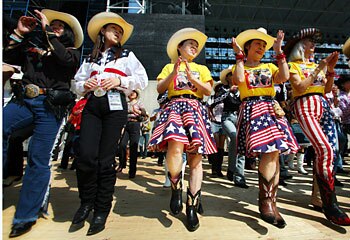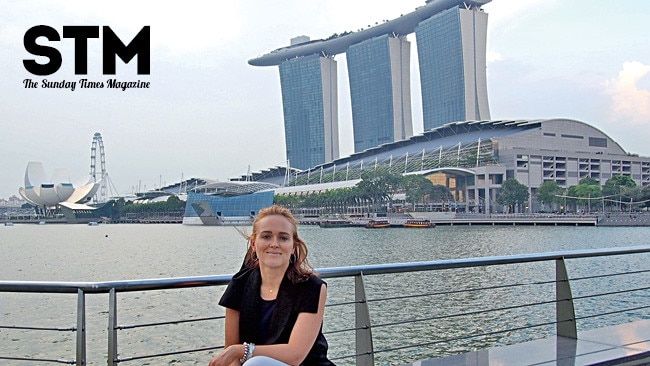Turning Japanese
BARRY Dick bypasses the big smoke on a whirlwind trip to Japan, where 128 million people live with what seems like a vending machine each.

MONKS with email addresses and temples with websites ... welcome to Japan in the modern world.
In this country of contradiction and challenge, fascination and fear, 128 million live with what seems like a vending machine each.
Extraordinary technology walks alongside traditions and cultures that go back centuries.
Thatched farm houses have satellite TV dishes and century-old city dwellings are adorned with airconditioning units.
People in massive apartment blocks unreservedly hang their washing for the world to see, but eye contact in a public bathhouse is regarded as an invasion of privacy.
Tourism between Australia and Japan is very much a one-way street.
Last year, Japan sent 685,672 tourists to Australia while the trickle the other way totalled 154,571.
So what's stopping us? There has been a perception that Japan is expensive, but with the Australian dollar hovering around 93 yen, costs have become much more palatable.
Still no one would call Japan a "cheap" destination.
My own "beer-o-meter" (based on the price of mini-bar beers) fluctuated wildly, from a whopping $10 at the Swissotel Nankai in Osaka to $6 at the Nikko in Kazayama and $4 at the Associa Takayama.
Meals are not expensive, especially in rural areas, and there is tremendous variety in the styles.
On a whirlwind visit in November we saw Japan at its multi-coloured best – with startling autumn hues.
We were lucky our hosts opted not to take us to Tokyo because it meant we experienced the rural side of Japan, which is often overlooked by business visitors and many tourists.
In the first three helter-skelter days, we visited six cities or towns, four temples, the world-class Miho museum, the famous Kanazawa Castle Park, two castles and a geisha house.
WE HAD two tea ceremonies, a vegetarian meal, a meditation experience (with a young monk walking behind with a cane to ensure we did not move), ate raw fish, shabu-shabu, sushi and sandwiches, and stayed at a ryokan (traditional inn) where we slept on futons, had hot mineral baths and took off and put back on our shoes a dozen times.
With our heads spinning, we headed from Kanazawa to Takayama by way of Shirakawago.
On the way to Shirakawago we stopped at the World Heritage-listed historic village of Gokayama, a perfect example of the sort of farming village that once dotted the northern Gifu and Toyama prefectures. The houses are built with steep thatched roofs so most of the snow slides off.
The structures are fascinating, but so is the fact that a couple of them have satellite television dishes, at least one had airconditioning and there was a vending machine attached to another.
Still, it wasn't hard to imagine just how tough life must have been for the hardy souls who inhabited these areas 100 years ago.
From Gokayama we went to lunch at a tiny restaurant called Masuenbunsuke, where we were to try "local cuisine". Now, there's a term to cause worry, because it covers so many culinary sins. What a delight it was then, to have one of the best meals we had on the trip.
Sure, there was the ubiquitous raw fish – an acquired taste that I still hadn't altogether acquired – soup and rice, but there also was smoked and roast trout, which were mouth-wateringly good.
It was a little disconcerting to be sitting at a window overlooking a pond of leaping local trout, knowing they might be eyeing us off as we munched on the relatives they were swimming with only an hour before.
After lunch we went to the open-air museum where 25 farmhouses had been transferred from the Kazura district, where they would have been drowned by a new dam, and restored. In some, tourists can see demonstrations of traditional crafts.
FROM Shirakawago we boarded the bus again for a two-hour run to Takayama city, which must be one of the great undiscovered, or at least under-used, world destinations.
This is a small city known for having retained its charm. They know how to cater for tourists but, from what we were told, can't attract them.
Only about 3000 Australians visit each year and that means about 150,000 other Aussies who go to Japan are missing out on quite an experience.
On our only full day in Takayama we managed somehow to squeeze in visits to the Miyagawa and Jinya-mae morning markets, a former local government office building and courthouse, the Takayama Festival Float Museum, Kusakabe and Yoshijima heritage houses and a tour of a sake brewery as well as lunch and a stroll through a shopping district without getting tired or bored. Although there was, I confess, a point when our collective eyes glazed over during a lengthy explanation of a building style.
The next day we (reluctantly in my case) left Takayama on the 9.42am limited express train, which left exactly at 9.42am and was scheduled to arrive in Nagoya at 12.09pm and rolled into the station at, well, well, 12.09pm to link with the 12.45pm Nozomi 215 bullet train to Shin-Osaka, which arrived in Osaka one minute early.
It was extremely hard, if not impossible, to absorb everything in such a hectic tour – especially when only one of us had been to Japan before – but each of us left Osaka the next night promising to come back, and to again avoid the really big smoke and head for Kanazawa and Takayama.
The writer travelled as a guest of the Japan National Tourist Organisation



